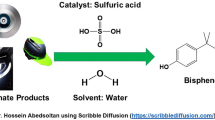Abstract
Polycarbonate (PC) pellets were subjected to dilute aqueous ammonia solution under hydrothermal conditions in a semi-batch reactor at temperatures ranging from 433 to 463 K and at a pressure of 10 MPa. The PC pellets were almost completely converted to bisphenol A (BPA). During an initial certain period, referred to as an induction time, neither BPA nor total organic carbon in solution were detected, and the BPA yield increased with time. The monomer yield was well represented by a surface reaction model, two-thirds-order reaction with respect to the mass of unreacted PC. The overall rate constant of the reaction in 0.6 mol/kg aqueous ammonia solution at 433 K was about 15 times greater than that in 0.6 mol/kg NaOH solution. The rate constant at 433 K was proportional to the ammonia or NaOH concentration. There was a correlation between the induction time and temperature, as well as the ammonia or NaOH concentration. By carrying out the reaction in aqueous mixtures of (NH4)2SO4 and NaOH at various concentrations of NaOH, ammonia was confirmed not to function as an alkaline reagent, but as a nucleophile reagent.









Similar content being viewed by others
References
Yearbook of chemical industry statistics 2010 (2011), Research and statistics department economic and industrial policy bureau, Ministry of economy, trade and industry, Japan
Goto M (2009) Chemical recycling of plastics using sub- and supercritical fluids. J Supercrit Fluids 47:500–507
Mormann W, Spitzer D (2005) Ammonolysis of polycarbonates with (supercritical) ammonia: an alternative for chemical recycling. In: Brunelle D, Korn MR (eds) Advances in polycarbonates, ACS symposium series 898. American Chemical Society, Washington, DC, pp 244–261
Mormann W, Spitzer D (2004) Ammonia as reagent or reaction medium for polymers. In: Brunner G (ed) Supercritical fluids as solvents and reaction media. Elsevier, Amsterdam, pp 593–616
Piñero R, García J, Cocero MJ (2005) Chemical recycling of polycarbonate in a semi-continuous lab-plant. A green route with methanol and methanol-water mixtures. Green Chem 7:380–387
Piñero-Hernanz R, García-Serna J, Cocero MJ (2006) Nonstationary model of the semicontinuous depolymerization of polycarbonate. AIChE J 52:4186–4199
Hata S, Goto H, Tanaka S, Oku A (2003) Viable utilization of polycarbonate as a phosgene equivalent illustrated by reactions with alkanedithiols, mercaptoethanol, aminoethanethiol, and aminoethanol: a solution for the issue of carbon resources conversion. J Appl Polym Sci 90:2959–2968
Hata S, Goto H, Yamada E, Oku A (2002) Chemical conversion of poly(carbonate) to 1,3-dimethyl-2-imidazolidinone (DMI) and bisphenol A: a practical approach to the chemical recycling of plastic wastes. Polymer 43:2109–2116
Zenda K, Funazukuri T (2008) Depolymerization of poly(ethylene terephthalate) in dilute aqueous ammonia solution under hydrothermal conditions. J Chem Technol Biotechnol 83:1381–1386
Arai R, Zenda K, Hatakeyama K, Yui K, Funazukuri T (2010) Reaction kinetics of hydrothermal depolymerization of poly(ethylene naphthalate), poly(ethylene terephthalate), and polycarbonate with aqueous ammonia solution. Chem Eng Sci 65:36–41
Wakabayashi N, Funazukuri T (2012) Recovery of terephthalic acid and ethylene glycol from poly(ethylene terephthalate) under hydrothermal conditions of aqueous trimethylamine solution. Ind Eng Chem Res 51:5699–5704
JSME (1999) (Japan society of mechanical engineers) Steam tables based on IAPWS-IF97 (International association for the properties of water and steam international formulation 1997 for the thermodynamic properties of water and steam), 5th edn. JSME, Tokyo
Tremaine P, Zhang K, Bénézeth P, Xiao C (2004) Ionization equilibria of acids and bases under hydrothermal conditions. In: Palmer DA, Fernández-Prini R, Harvey AH (eds) Aqueous systems at elevated temperatures and pressures: physical chemistry in water, steam and hydrothermal solutions. Elsevier, Amsterdam, pp 441–492
Yagihashi M, Funazukuri T (2010) Recovery of l-lactic acid from poly(l-lactic acid) under hydrothermal conditions of dilute sodium hydroxide solution. Ind Eng Chem Res 49:1247–1251
Acknowledgments
We are grateful to the Ministry of Education, Sports, Culture, Science and Technology of Japan for the financial support through Grant-in-Aid #23651075 and to the Japan Society for the Promotion of Science for the financial support through the A-step grant.
Author information
Authors and Affiliations
Corresponding author
Rights and permissions
About this article
Cite this article
Hatakeyama, K., Kojima, T. & Funazukuri, T. Chemical recycling of polycarbonate in dilute aqueous ammonia solution under hydrothermal conditions. J Mater Cycles Waste Manag 16, 124–130 (2014). https://doi.org/10.1007/s10163-013-0151-8
Received:
Accepted:
Published:
Issue Date:
DOI: https://doi.org/10.1007/s10163-013-0151-8




